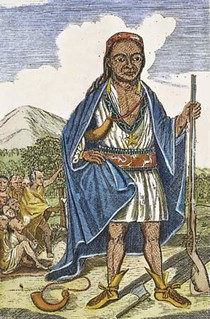
PREV ARTICLE
NEXT ARTICLE
FULL ISSUE
PREV FULL ISSUE
NEWMAN HISTORIC AMERICAN FISCAL PAPERMaureen Levine and cataloguer Bruce Hagen submitted this article highlighting five importamt items of American fiscal paper from the Heritage Eric P. Newman Collection Internet Part
3 sale. Thanks! These are some amazing pieces. -Editor
The loan certificates in Selections from the Eric P. Newman Collection Internet Part 3 are significant examples of the instruments used for financing the American Revolution. Lot 89364: Massachusetts 1775 "King Phillip" Bond
 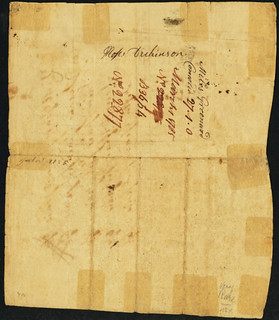 The King Philip bonds engraved by Paul Revere are noteworthy as the first loan certificates used in financing the American Revolution: Colony of the Massachusetts Bay - Provincial Act of May 3, 1775 6% Loan due June 1, 1777. 5 Pounds 4 Shillings Augt. 10, 1775 Anderson-Smythe MA-1. PCGS Very Fine 20 Apparent. A historic rarity printed on “American Paper” from copper plates engraved by Paul Revere. In The Price of Liberty, Anderson writes: “These certificates represent the first attempts to finance the Revolution; they preceded the first currency issues of Massachusetts and the Continental Congress by three and seven weeks respectively.” Authorization was based upon Colonial enactments passed during the reign of George II, specifically the Royal General Court’s June 20, 1744, “Act for ascertaining the Rates at which coined Silver & Gold, English half pence & farthings, may pass within this Goverment [sic]… ,” and is engraved within the obligations. The oblong vignette cut in the indented left end shows Native American King Philip (Metacom) with a codfish emblem near the top and “CMB” monogram at the bottom. This impressive financial instrument evokes the spirit of the early Revolutionary War. Who was King Philip? Here's a excerpt from Brittanica,com. -Editor
Metacom’s dignity and steadfastness both impressed and frightened the settlers, who eventually demonized him as a menace that could not be controlled. For 13 years he kept the region’s towns and villages on edge with the fear of an Indian uprising. Finally, in June 1675, violence erupted when three Wampanoag warriors were executed by Plymouth authorities for the murder of John Sassamon, a tribal informer. Metacom’s coalition, comprising the Wampanoag, Narraganset, Abenaki, Nipmuc, and Mohawk, was at first victorious. However, after a year of savage fighting during which some 3,000 Indians and 600 colonists were killed, food became scarce, and the indigenous alliance began to disintegrate. Seeing that defeat was imminent, Metacom returned to his ancestral home at Mount Hope, where he was betrayed by an informer and killed in a final battle. He was beheaded and quartered and his head displayed on a pole for 25 years at Plymouth. To read the complete article, see: Metacom WAMPANOAG LEADER (www.britannica.com/biography/Metacom) Bruce Hagen adds: King Philip has two different vignette styles appearing on Obsolete Currency, both rare and initially for use on Rhode Island. Interestingly, the King Philip version engraved by Wellstood, Hay & Whiting also appeared on Indiana notes (frontier Indian vignettes often favored by midwest bankers then). The Metacomet Bank title was used on Fall River, Massachusetts notes that crossed over geographically to Rhode Island as well. To read the complete lot description, see:
Lot 89370: Massachusetts 6% Treasury Loan Certificate
 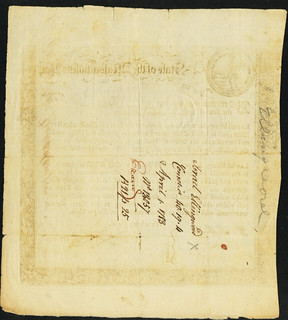 Next is the historic Massachusetts Bay “Sword in Hand” certificate engraved by Nathaniel Hurd: State of the Massachusetts Bay – (Act of May 2, 1777) 6% Treasury Loan Certificate due June 1, 1780 35 Pounds March 20, 1778 Anderson-Smythe MA-8. This bond is from the “Sword in Hand” emblem series featuring additional authorizations and redemption due dates. These have another very iconic Massachusetts engraved style. Printed from a Nathaniel Hurd plate on laid paper. At upper left, a rattlesnake frames a standing patriot holding a sword and the INDE/PEND/ENCE scroll; the Latin motto circling around is ENSE PETIT PLACIDAM SUB LIBERTATE QUIETAM (By the sword we seek peace, but peace only under liberty, the Commonwealth of Massachusetts motto). Printed from a well-inked, early state plate, and exemplifying this Nathanial Hurd “Sword in Hand” bond well. To read the complete lot description, see:
Lot 89390: New-York 6% Six Month Loan Certificate
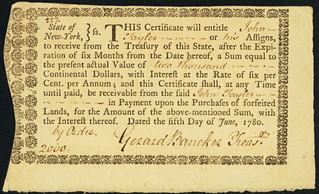 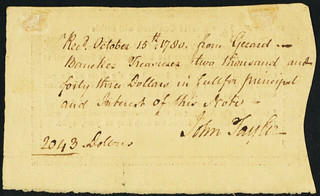 The first example we have seen of this rare, six-months New York certificate: State of New-York – Treasury of this State 6% Six Month Loan Certificate “…upon the Purchases of forfeited Lands” 2000 Continental Dollars June 5, 1780 Anderson- Smythe NY-UNL. PCGS Choice About New 55 Apparent. A remarkable and exceedingly rare small-format certificate from New York. The great rarity of this loan certificate is due to the short term of six months and the fact that it is from New York (all New York fiscal paper is rare). The certificate may have been redeemed for State of New York “Guaranteed by the United States” notes, which are the rarest from that State-issued Colonial currency series. It appears most of those notes were eventually redeemed for subsequent instruments, and the remaining Guaranteed notes were destroyed by the State. A very important New York Colonial fiscal piece and the first we have seen. Note the use of the hyphenated "New-York", an early practice carried on today by the New-York Historical Society. -Editor
To read the complete lot description, see:
Lot 89353: Continental Loan Office Livres Tournois Certificate
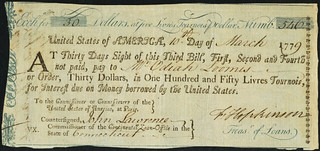  Certificates for loans issued from the Continental Loan Office comprise a series of United States obligations collected with Colonial American currency and United States Federal Loans. These Bill of Exchange certificates were denominated in dollars and European equivalents depending on whether they were ultimately payable abroad or domestically at an authorized location. They represented the interest payments due for “Money borrowed by the United States” from the federal loan sales made at individual state loan offices as noted at the lower left of the obligations. They were printed in sheets of four “Bills,” from a “First” at the top to a “Fourth” at the bottom. One or more could be sent simultaneously as necessary for payment abroad. Upon redemption of a First Bill, the other three would be void. According to William G. Anderson in The Price of Liberty, “If the first bill was lost or captured at sea ... the holder would then send the second bill; if it too was lost, he would send the third, and so on. In several instances Congress authorized duplicate sets issued when all four had been lost at sea ...” Only two “First Bills” have been confirmed extant as almost all were redeemed or destroyed. The majority known are Fourth Bills. This Third Bill, payable “at Paris,” has an outstanding Francis Hopkinson signature: United States of America - Continental Loan Office in the State of “Connecticut” Exchange for $30/150 Livres Tournois Third Bill, Payable at Paris March 10, 1779 Anderson-Smythe US-97- 1A. This Connecticut certificate is representative of the most commonly encountered “at Paris” series. Printed on laid paper, watermarked “United States 3.” The exchange bill numeral is incorporated into the watermark for counterfeit deterrence. According to author and collector Ned W. Downing, the molds for the watermarked laid paper were fashioned by Nathan Sellers, who was released from military service for this purpose. The Francis Hopkinson (signer of the Declaration of Independence) signature is superb. Though Connecticut Livres Tournois certificates are available, the condition of this example makes it an ideal type piece from a most interesting chapter in the early debt financing of the United States. One evening at dinner I said to my wife, "I've always wanted to say this - today we got a wire transfer from Sotheby's in London." It wasn't from the sale of
the spare Renoirs from our country house, but for a $100 ad on the NBS web site. In the age of PayPal and all manner of electronic transfers it's hard to fathom a time when the financial system
was fraught with months-long delays and physical dangers. Yet it's amazing to see how humans coped with and somehow managed to survive in the face of so many frustrating obstacles to their daily
business. -Editor
To read the complete lot description, see:
Lot 89359: Continental Loan Office Holland Bill of Exchange
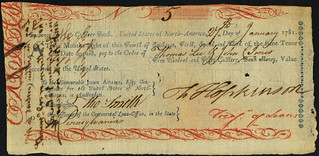 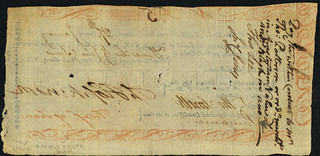 Rounding up the Colonial fiscal paper highlights in Newman Internet 3 is a very rare Holland Bill of Exchange payable at John Adams’s American Mission in Amsterdam: United States of North-America – Continental Loan Office in “Pennsylvania” 550 Guilders Fourth of Exchange, Payable to “Honourable John Adams…in Amsterdam” January 27, 1781 Anderson-Smythe US-107-10A. A Loan Office certificate issued from the Pennsylvania Loan Office through John Adams’s efforts in Amsterdam. While Franklin and Jefferson experienced the glamor of Paris life and dealt with the French nobility, Adams negotiated with a much more prudent Holland merchant elite while at the American Mission. This multi-colored certificate has a much different appearance from those with the Paris payable. Though High Rarity-6 (13-20 known) in Anderson-Smythe, by observation this is much rarer. An important opportunity to obtain a significant artifact of early American financing showcasing John Adams’s role as an Amsterdam diplomat. Another interesting obsolete name: "United States of North-America". The Dutch connection in early American history is often overlooked, but was a huge influence in the
developing country. -Editor
To read the complete lot description, see:
This auction of selections from Eric P. Newman’s collection offers many opportunities for both novices and sophisticated collectors. To view the complete sale, please visit www.ha.com/241626 These early fiscal documents were critical in the founding of the nation and represent tangible connections to the hard work of the Founding Fathers. Closely related to colonial
paper money, these rare fiscal paper items are even more important as primary historical source documents. The sale is a great opportunity to acquire some amazing rarities. -Editor
To read the earlier E-Sylum article, see:
Wayne Homren, Editor The Numismatic Bibliomania Society is a non-profit organization promoting numismatic literature. See our web site at coinbooks.org. To submit items for publication in The E-Sylum, write to the Editor at this address: whomren@gmail.com To subscribe go to: https://my.binhost.com/lists/listinfo/esylum All Rights Reserved. NBS Home Page Contact the NBS webmaster 
|
